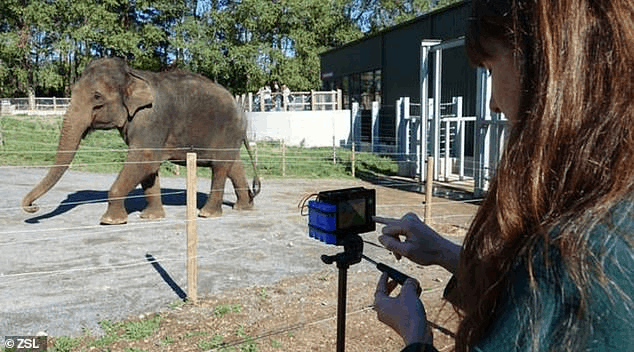In a groundbreaking initiative, UK zookeepers have amassed an extensive collection of elephant selfies, harnessing these images to train thermal cameras for enhanced wildlife detection.
The project, led by the Zoological Society of London (ZSL) at Whipsnade Zoo in Bedfordshire, focuses on Asian elephants and aims to utilize technology to safeguard these endangered creatures in their natural habitat.
Watch the video at the end.
Using thermal imaging cameras, over 30,000 images of Asian elephants have been captured at Whipsnade Zoo.

These cameras can accurately identify the unique heat signatures of the zoo’s elephants, enabling round-the-clock tracking, even in complete darkness.
The ultimate goal is to employ these cameras in the wild, where they will promptly notify local communities or response teams of elephant presence through text messages.

This innovative approach holds the potential to mitigate human-elephant conflicts, a significant threat to the survival of these majestic animals.
Conflict arising from the encroachment of human settlements into elephant territories can have dire consequences.
Alasdair Davies, a conservation technology expert at ZSL, stressed the importance of coexistence, stating, “We want to get this into the field now and put it in the wild, helping wild animals and communities live side-by-side.”

The Asian elephant, categorized as endangered on the IUCN Red List, faces mounting challenges due to habitat loss driven by human population growth.
The expanding human presence restricts elephants to smaller areas, leading to heightened conflict instances.
ZSL’s efforts have resulted in developing a model capable of confidently identifying elephants and people from distances of up to 100 feet.
Collaborating with Colchester Zoo, ZSL extended its data collection to include African elephants, considering the distinct physical attributes of both species.
This inclusivity ensures the technology’s applicability across different continents, considering variations like the size and shape of elephant ears.
The journey involved curating various thermal images, each meticulously labeled to “train” the camera technology. As the system continues to learn and adapt, its accuracy in elephant detection is expected to improve over time.
ZSL’s next phase includes crafting prototype cameras for on-field deployment with the assistance of conservation partners.
The critical nature of the human-elephant conflict cannot be understated. Crop raiding, where wild animals damage cultivated plant crops, is a prominent source of tension between humans and elephants.
These clashes can escalate to violent confrontations, as witnessed when enraged villagers attacked elephants after crop damage.
ZSL, however, is committed to broader conservation efforts, extending its work to Thailand, a crucial stronghold for Asian elephants.
By integrating advanced technologies and educating local communities, ZSL seeks to comprehend the root causes of crop raiding and implement strategies for conflict reduction.
In this trailblazing endeavor, UK zookeepers and conservationists are spearheading the use of thermal imaging and innovative technology to foster harmonious coexistence between humans and elephants, ensuring the survival of these remarkable creatures for generations to come.